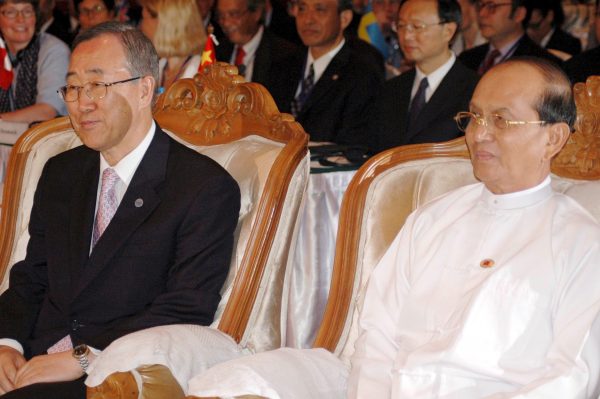General Thein Sein, then the prime minister, chaired the meeting. Surprisingly, he wore Myanmar’s traditional business attire (taikpone and longyi) rather than his usual military uniform. Some might have overlooked this fashion signal, but it seemed to endorse the need to transform Myanmar into a civilian rather than a military regime. After three years, Thein Sein went from prime minister and general to president — dispensing with his green uniform once and for all.
In 2014, Myanmar is set to host the top-level ASEAN summits for the first time, under the theme of ‘Moving Forward in Unity towards a Peaceful and Prosperous Community’. Apart from the usual fancy and fashionable tailor-made dress occasions, will Thein Sein decide to wear an international outfit rather than the usual Myanmar attire? Wearing a business suit could be seen as a strong signal to the international community of Myanmar’s return to the international arena. As one of the few countries that has successfully kept its traditional outfit as business attire, it would be a pity if Myanmar decides to change into Western dress. But through the attire it displays on the world stage at this event, Myanmar can show that it is part of ASEAN and the broader international community.
This is a crucial year for Myanmar. It still faces domestic challenges, or ‘growing pains’, such as communal conflict, progress on the peace process, constitutional amendments and the huge logistical exercise of the census which requires co-operation from ethnic armed groups. This year it will choose the next steps in its reforms through two critical political processes. First is progress toward peace through countrywide ceasefires and political dialogues with ethnic armed groups. Second is amending the constitution, including article 59(f) which dictates the qualifications required of any prospective president.
But if Myanmar wants to demonstrate ‘we can do it’ for ASEAN leadership — as it did for the Southeast Asian Games in December 2013 — the country has to be careful domestic issues, especially the communal conflict that still haunts Myanmar, do not attract scrutiny by ASEAN.
Myanmar’s policymakers will not want any of the nation’s domestic issues to become part of the core ASEAN agenda, and so hamper ASEAN meetings during its chairmanship. As such, Myanmar is expected to be extremely careful in tackling domestic issues. In addition, Myanmar may accept friendly gestures supporting its chairmanship. Therefore, the international community should do what it can to collaborate with Myanmar in order to support its further democratisation process during its chairmanship.
On the other hand, there has been media speculation about Myanmar’s capability in stewarding ASEAN, with criticisms ranging from the logistical to the substantive. Singapore-based ASEAN analyst Moe Thuzar predicted that Myanmar would have to host around 240 to 400 meetings, including major regional summits and ministerial meetings. She suggested that Myanmar might have gained experience from being a member of ASEAN for more than 16 years, but pointed out that domestic affairs such as communal conflict might affect its chairmanship. She also suggested that ASEAN could measure Myanmar’s performance through the prism of the South China Sea dispute between China and some ASEAN member states.
With logistical and resource constraints compounding domestic challenges, Myanmar may feel that its job has been accomplished with photo opportunities and a magnificent opening ceremony that goes off without any security or logistical glitches — all without touching on sensitive and complex regional issues such as the South China Sea controversy.
But such an approach could lead to relatively modest outcomes for Myanmar. Justine Drennan, writing for The Diplomat, has warned Myanmar to learn from Cambodia’s bitter experience, when it was perceived as being under the heavy influence of China, its major donor. In the case of Myanmar, Nay Pyi Taw has a convention centre that was a token of friendship from the Chinese government. But — in an unexpected move — Myanmar recently opened another glamorous convention centre in Nay Pyi Taw for the sole purpose of hosting the ASEAN Summit, a symbolic move that may be interpreted as Myanmar taking charge.
One should not underestimate Myanmar’s long-term vision of becoming a regional powerhouse. Its strategic geographical position as well as its size affords it this opportunity. Myanmar foreign policymakers still remember the nation’s glory days at the Trusteeship Council of the United Nations and in the Non-Aligned Movement where it was a driving force of the success of these organisations during the 1950s and 1960s. The position of ASEAN chair may awaken Myanmar’s foreign policy ambitions once again.
Against all these domestic and logistical odds, while ASEAN may have tempered expectations of Myanmar’s leadership, the fashion signal of President Thein Sein, will be worth our attention. Whether he wears a lounge suit or traditional attire, might at least reveal Myanmar’s willingness to engage with future challenges.
Chit Win is a PhD candidate at the School of International, Political and Strategic Studies in the ANU College of Asia and the Pacific.
This article appeared in the most recent edition of the East Asia Forum Quarterly,‘On the edge in Asia’.

